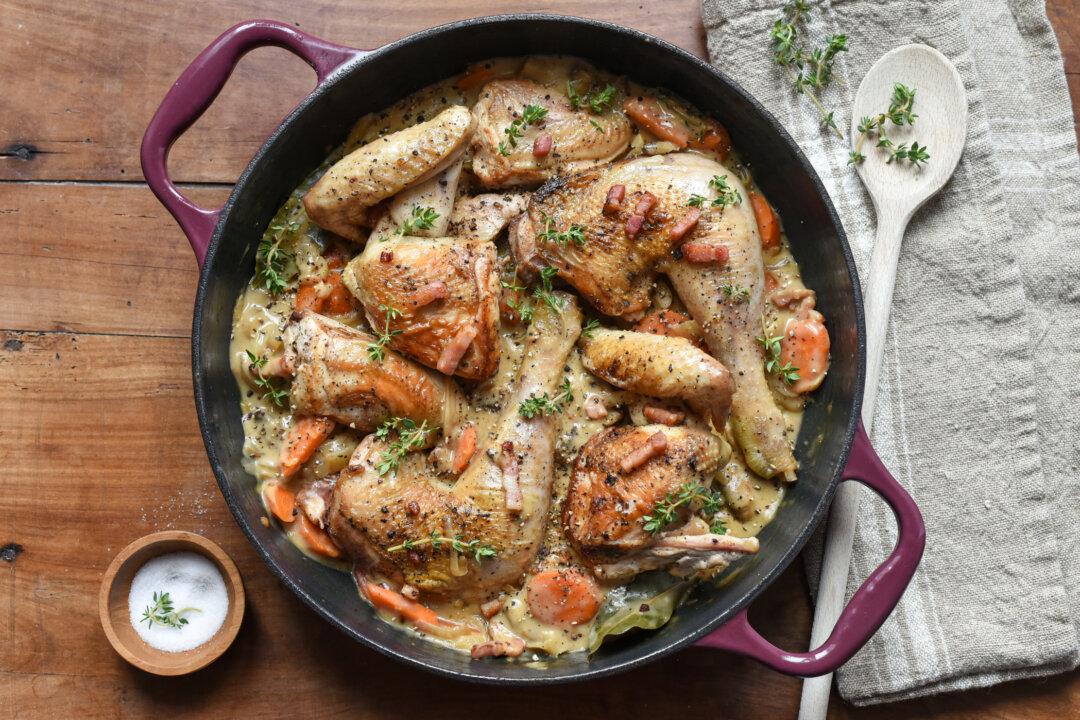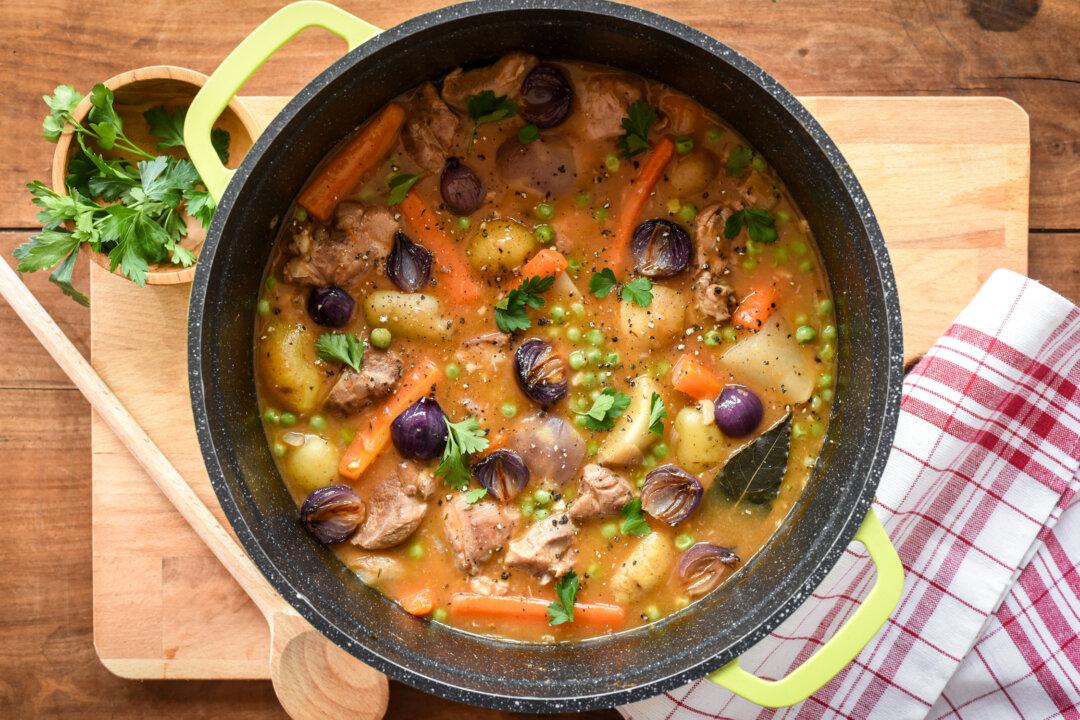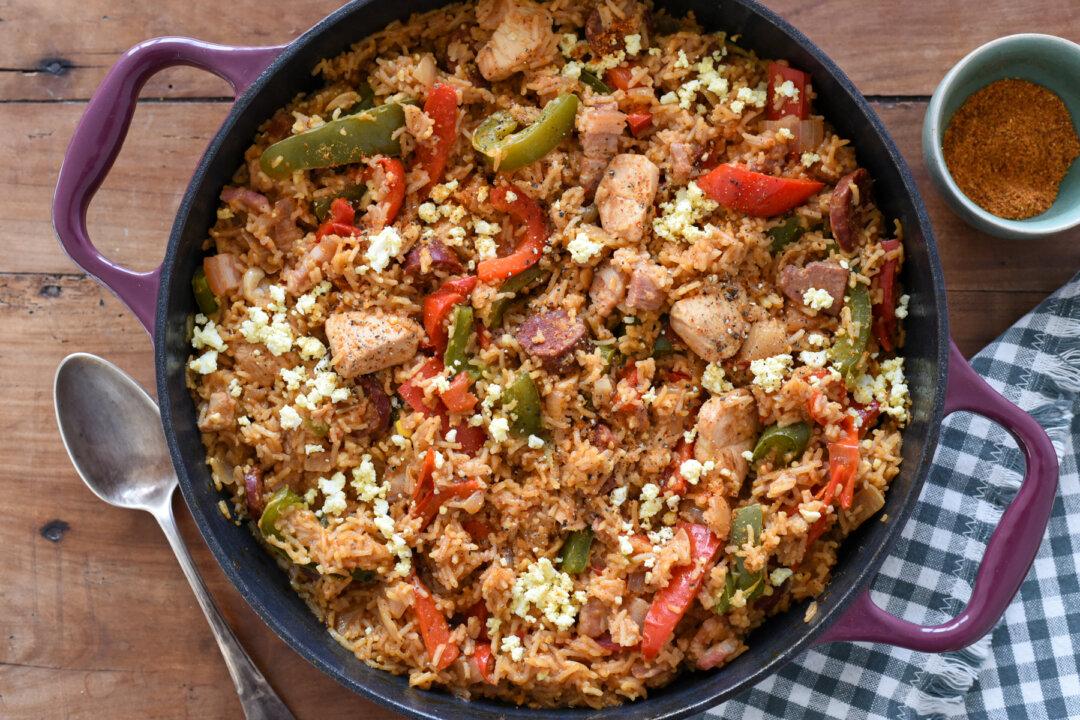Chicken, fresh tarragon, cream, and white wine are no strangers to a French kitchen, and they all come together wonderfully in this classic French bistro dish. Known as “poulet à l’estragon,” French tarragon chicken is a simple, one-pan recipe that’s a little more impressive than your average chicken stew.
With fresh tarragon season running from late spring to early autumn, this recipe is ideal for spring and summer menus, whether a weeknight dinner or a gathering.
The dish is the perfect combination of old-school comfort—with tender chicken in a rich, creamy sauce—and freshness—thanks to the assertive aromatics of tarragon. Chicken pieces are first browned and braised in white wine, a popular French cooking technique for tender, juicy results. Then, cream is added for extra richness.
But it’s really the fresh tarragon, a staple herb in French cooking with its aniseed-like notes, that gives this unique dish its distinctive flavor.

French tarragon's aromatic leaves have a flavor akin to aniseed and licorice. Hortimages/Shutterstock
The Real Deal
An essential in the French kitchen, tarragon is one of the four “fine herbs” of French cooking—along with parsley, chive, and chervil. These fresh herbs are widely employed to give flavor to dishes that rely on a short cooking time (such as chicken or fish dishes). They create the classic flavors you find in béarnaise sauce, or various French salads.For this recipe, make sure you get French tarragon, and not Russian (sometimes called “impostor” tarragon). Slightly more expensive, French tarragon is said to be the “real” tarragon, with very aromatic leaves that have a flavor akin to aniseed and licorice. In comparison, Russian tarragon has a weaker flavor, is less sweet, and can have bitter overtones. It also tends to lose its flavor when cooked, so it won’t deliver the signature flavor of the dish.
Based on their appearance, it can be hard to differentiate between the two herbs, so if you are unsure what type of tarragon you have in hand, do a taste test. The leaves of French tarragon should have a clear aniseed flavor with a unique tongue-numbing effect. Russian tarragon will give you very little, if any, aniseed taste.

Be sure to use bone-in chicken pieces, and take them out of the fridge and salt them 1 hour before you start cooking. Audrey Le Goff
Chicken Tips
French chicken tarragon is meant to use a whole bird, cut into pieces. I recommend you buy the best quality bird you can find; a locally raised and free-range one is ideal.Bone-in pieces truly impart so much flavor to this dish, so I recommend you go this route. If you are shy about butchering the chicken, you can ask your butcher to cut the chicken into six pieces: two quarters, two wings, and two breasts (and keep the carcass to make stock!).
As with most chicken recipes, it’s best to take the chicken pieces out of the fridge and salt them at least one hour prior to starting the recipe. This allows the chicken to come closer to room temperature, for the best texture, and allows the salt to penetrate the chicken meat for the best taste.
Leaving the skin on the chicken is also essential to this recipe. The chicken will be first cooked, skin-side down, in the pan. The fat from the skin will melt and render into the pan, so it can be used to caramelize the onions and garlic, and as a base for the sauce. It will contribute greatly to building flavors in this dish. You can choose to remove the skin later, on your plate, once the dish is served.
French Tarragon Chicken
For this recipe, you will need a large skillet or Dutch oven (with a lid) that can go from the stovetop to the oven. For the white wine, I recommend you choose one that is dry and crisp, such as sauvignon blanc, pinot grigio, pinot gris, or pinot blanc.You can make this recipe the day before, and re-heat it on the stovetop over low heat just before serving. I think this dish is actually even better reheated the next day, which is great to save time when hosting a dinner party.
Serves 4 to 6
- 1 whole chicken, cut into 6 pieces
- 2 teaspoons salt
- 1 teaspoon freshly ground black pepper
- 2 tablespoon butter, unsalted
- 1 medium onion, peeled and sliced
- 2 garlic cloves, peeled and diced
- 1 cup chicken stock, ideally low sodium
- 1/2 cup dry white wine
- 2 tablespoon fresh tarragon, chopped, plus extra for garnish
- 1/2 cup heavy cream
- More salt, pepper to taste
Preheat your oven to 375 degrees F with a rack in the middle.
Heat up a large oven-safe frying pan (or skillet) over medium heat with the butter. When the butter is sizzling, place the chicken pieces in, skin-side down. Cook for about 10 minutes, without touching, until the chicken skin is golden brown and the chicken is 3/4 done. Flip the chicken pieces and cook for 10 more minutes. Transfer the chicken to a plate and cover with foil. Keep the pan hot and do not rinse it (keep the chicken drippings in).
Add the onion and garlic to the pan. Cook for about 10 minutes, stirring occasionally, until the onion is lightly caramelized. Nestle the chicken pieces back into the pan, on top of the onion. Sprinkle with the chopped tarragon. Pour the chicken stock and white wine into the pan. Bring to a simmer and transfer the pan into the oven for 30 minutes (covered).
Take the pan out of the oven, back onto the stove top at medium heat. Transfer the chicken to a plate and cover with foil again. Stir the cream into the pan. Bring to a simmer and keep stirring until the sauce thickens (this should take 7 to 8 minutes). Place the chicken pieces back into the pan and cook for 5 more minutes.
For serving, sprinkle chicken pieces with fresh tarragon leaves.





